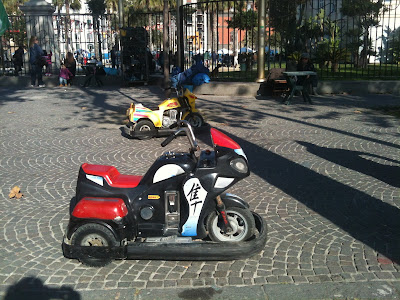History
It was first built as a paved road between Piazza Vittoria and Piedigrotta by the Spanish viceroy Duke of Medinaceli in 1697 who adorned it with thirteen fountains and two rows of willow trees on each side. Later, it became a Royal Promenade known as Villa Reale and sitting directly on the shore, provided a much needed buffer between the hustle and bustle of the city to the north and the tranquil sea to the south.
That however was in the days when women donned gowns to stroll through the park and when only the rich, the royals, and the famous graced its promenade. That is except for once a year on September 9th during the Festa di Piedigrotta, when all citizens were welcomed into the park, provided of course that they wore shoes. The Neapolitans still flock to Villa Comunale to celebrate that festival today.
Quoting from Napoli Unplugged website
Today
Johnnie and I are privileged to live right across the street from this lovely park. They do not water in the summer so when we first came, everything was brown and rather dusty. But with the rains this Fall, the the plants and trees have turned green again and the dust settled so it is quite lovely. We took some photos last Sunday which do not do it justice but how can you capture on film the spirit of a place?
 |
| One of the many fountains |
 |
| Many walking paths throughout the park |
Old and young alike use this park. We enjoyed a leisurely stroll, sitting on the park bench watching people, and of course, feeding the ever-present park pigeons.
 |
| Pedal powered vehicle for those who want exercise |
 |
| Battery powered child size go carts |
We find these go carts on the sidewalks outside the park wherever the children leave them. The park attendants patiently go around and retrieve them all at the end of day.
This is a very neat bandstand with stained glass dome. It was chained off last Sunday but presumably is open for special events, weddings, concerts, etc. Looking at the inside of the roof structure, I thought it was an interesting design and construction. The frame and supports are all metal -- steel I guess -- and the decorative edges are very fine and lacey.
There are lots of statues in the park placed by during the late 1800's and early 1900's that honor different heroes of Naples. This particular statue has no inscription so I don't know who he is, however, this is housed in it's very own building as seen in the photo below.
In addition to all previously mentioned is a roller skating rink, swing set and jungle gym, and an assortment of antiques and collectibles as well as some tourist junk. We have only explored part of this lovely park and look forward to many fine Sunday afternoon strolls here in future






No comments:
Post a Comment